The Adolf Hitler Page. Not a Tribute.
Hitler's Skull With A Bullet hole in it: LOL!
This photograph was taken by a Russian museum where the skull resides in a dark drawer, not on display. It purports to be authentic but I'm not entirely certain. Although I still enjoy it immensely. He never looked better!
Good shot Adolf!
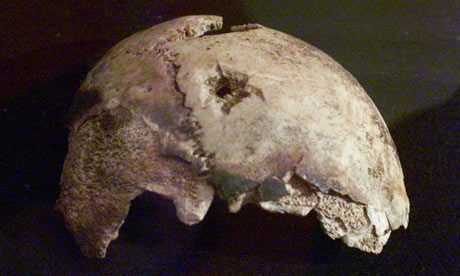
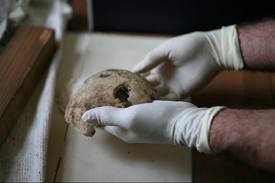
Inside Hitler's Head:
Hitler's medical X-ray from the Allied Military Intelligence Service Center, United States Army, European Theater.
This is one of five known X-rays of Hitler's head, part of his medical records captured by American military intelligence after the Nazi surrender. The X-ray was declassified in 1958.
How much evil can you spot?
I think I can spot where he hates us all. And himself.
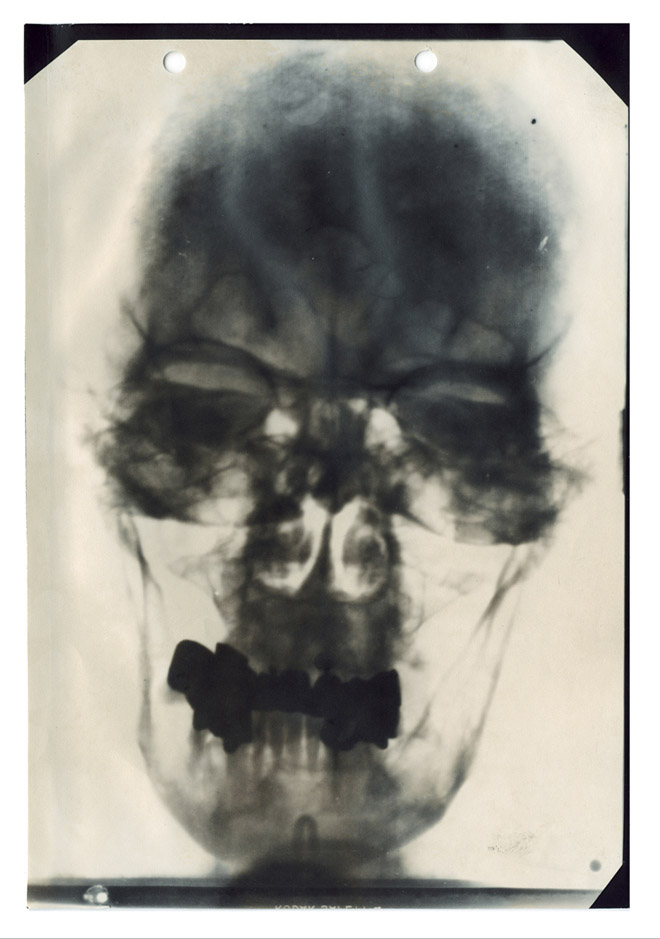
Hitler's Signature:
On the original of the Nuremberg Laws persecuting the Jews.
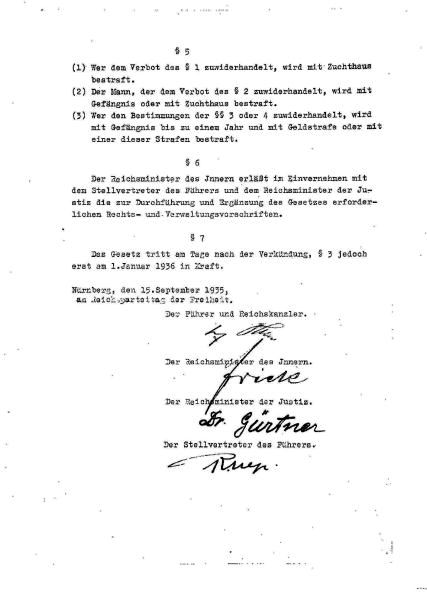
The Actual Cyanide Capsule Goring Used To Commit Suicide
I know it's not Hitler's and this is the Hitler Page, but I just enjoy looking at this thing.
If only Hitler had borrowed it after the failed Munich Putsch!
Chew up Adolf!
Hitler as a baby.
Of all the Hitler photographs I've ever seen, this one is the creepiest.
Not because he kept the same hairstyle his whole life, but because the baby doesn't look at all evil. Looking at this baby, you would never know.
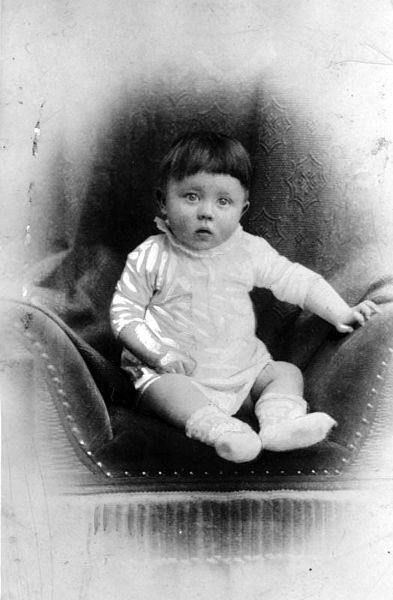
Hitler Secretly Recorded Speaking in Finland in 1942
This is the only extant recording of Hitler using a normal speaking voice. He had all recordings of himself speaking normally erased and banned in order not to reveal his idiomatic Austrian accent to the German people.
This was recorded in a train carriage by a Finnish radio technician. He was caught and threatened with death by the Nazis unless he erased the recording. The technician pretended to erase it, but kept a copy.
It has deliberately been kept hidden in Finnish National Radio archives for 70 years since WW2 - and it is still not freely available to the public. Except here.
This is simply too important an historical document to allow anyone to withhold it for any reason. It belongs to the world public domain. Finland National Radio should be more ashamed of witholding the document than they are of its potentially collaborationist contents, which Finnish governments have presumably found embarrassing since WW2.
Two years after this conversation took place Mannerheim directed the Finnish government to make a pact with the Nazis that Finland would not make a a separate peace in the war with the Soviet Union without the approval of Nazi Germany. He personally distanced himself from this pact. At that time Finland were responding to an invasion of their territory by the Soviet Union. Their collaboration with the Nazi Army was one of convenience rather than aggression.
Baron Carl Gustaf Emil Mannerheim (4 June 1867 – 27 January 1951), was the Commander-in-Chief of Finland's National Forces, Marshal of Finland and a politician. He was Regent of Finland (1918–1919) and the President of Finland (1944–1946). He is a Finnish national hero. On 5 December 2004, Mannerheim was voted as the greatest Finnish person of all time by the Finnish public.
Hitler Speaking Voice - Finland meeting 1942, the only recording of him in conversation - 11 minutes
Hitler recorded in private conversation with Finnish Marshal Mannerheim. Only these two men speak.
Hitler speaks first. And by far the most. Almost all the speaking is Hitler, Mannerheim only interjects and comments.
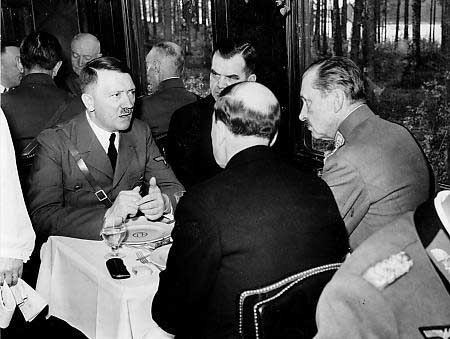
Hitler Recorder secretly 1942 Finland in Rail Car with Mannerheim
Taking part in the conversation secretly recorded on the 75th birthday celebrations of Marshal Mannerheim were Adolf Hitler (left), Finnish Prime Minister Jukka Rangell, President Risto Ryti (back toward the camera), and Mannerheim himself (right).
The English Transcript of the Conversation
The Hitler - Mannerheim Conversation:
The transcript starts with Hitler talking as follows, italics were used to emphasize the heightening of their voices in the original voice recording. I also have removed all the "uh's" and repeated words to make the dialog easier to read.
Hitler: ...a very serious danger, perhaps the most serious one - it's whole extent we can only now judge. We did not ourselves understand - just how strong this state [the USSR] was armed.
Mannerheim: No, we hadn't thought of this.
Hitler: No, I too, no.
Mannerheim: During the Winter War - during the Winter War we had not even thought of this. Of course...
Hitler: (Interrupting) Yes.
Mannerheim: But so, how they - in reality - and now there is no doubt all they had - what they had in their stocks!
Hitler: Absolutely, This is - they had the most immense armaments that, uh, people could imagine. Well - if somebody had told me that a country - with...(Hitler is interrupted by the sound of a door opening and closing.) If somebody had told me a nation could start with 35,000 tanks, then I'd have said: "You are crazy!"
Mannerheim: Thirty-five?
Hitler: Thirty-five thousand tanks.
Another Voice In Background: Thirty-five thousand! Yes!
Hitler: We have destroyed - right now - more than 34,000 tanks. If someone had told me this, I'd have said: "You!" If you are one of my generals had stated that any nation has 35,000 tanks I'd have said: "You, my good sir, you see everything twice or ten times. You are crazy; you see ghosts." This I would have deemed possible. I told you earlier we found factories, one of them at Kramatorskaja, for example, Two years ago there were just a couple hundred [tanks]. We didn't know anything. Today, there is a tank plant, where - during the first shift a little more than 30,000, and 'round the clock a little more than 60,000, workers would have labored - a single tank plant! A gigantic factory! Masses of workers who certainly, lived like animals and...
Another Voice In Background: (Interrupting) In the Donets area?
Hitler: In the Donets area. (Background noises from the rattling of cups and plates over the exchange.)
Mannerheim: Well, if you keep in mind they had almost 20 years, almost 25 years of - freedom to arm themselves...
Hitler: (Interrupting quietly) It was unbelievable.
Mannerheim: And everything - everything spent on armament.
Hitler: Only on armament.
Mannerheim: Only on armament!
Hitler: (Sighs) Only - well, it is - as I told your president [Ryte] before - I had no idea of it. If I had an idea - then I would have been even more difficult for me, but I would have taken the decision [to invade] anyhow, because - there was no other possibility. It was - certain, already in the winter of '39/ '40, that the war had to begin. I had only this nightmare - but there is even more! Because a war on two fronts - would have been impossible - that would have broken us. Today, we see more clearly - than we saw at that time - it would have broken us. And my whole - I originally wanted to - already in the fall of '39 I wanted to conduct the campaign in the west - on the continuously bad weather we experienced hindered us.
Our whole armament - you know, was - is a pure good weather armament. It is very capable, very good, but it is unfortunately just a good-weather armament. We have seen this in the war. Our weapons naturally were made for the west, and we all thought, and this was true 'till that time, uh, it was the opinion from the earliest times: you cannot wage war in winter. And we too, have, the German tanks, they weren't tested, for example, to prepare them for winter war. Instead we conducted trials to prove it was impossible to wage war in winter. That is a different starting point [than the Soviet's]. In the fall of 1939 we always faced the question. I desperately wanted to attack, and I firmly believed we could finish France in six weeks.
However, we faced the question of whether we could move at all - it was raining continuously. And I know the French area myself very well and I too could not ignore the opinions, of many of my generals that, we - probably - would not have had the élan, that our tank arm would not have been, effective, that our air force could not been effective from our airfields because of the rain.
I know northern France myself. You know, I served in the Great War for four years. And - so the delay happened. If I had in '39 eliminated France, then world history would have changed. But I had to wait 'till 1940, and unfortunately it wasn't possible before May. Only on the 10th of May was the first nice day - and on the 10th of May I immediately attacked. I gave the order to attack on the 10th on the 8th. And - then we had to, conduct this huge transfer of our divisions from the west to the east.
First the occupation of - then we had the task in Norway - at the same time we faced - I can frankly say it today - a grave misfortune, namely the - weakness of, Italy. Because of - first, the situation in North Africa, then, second, because of the situation in Albania and Greece - a very big misfortune. We had to help. This meant for us, with one small stoke, first - the splitting of our air force, splitting our tank force, while at the same time we were preparing, the, tank arm in the east. We had to hand over - with one stroke, two divisions, two whole divisions and a third was then added - and we had to replace continuous, very severe, losses there. It was - bloody fighting in the desert.
This all naturally was inevitable, you see. I had a conversation with Molotov [Soviet Minister] at that time, and it was absolutely certain that Molotov departed with the decision to begin a war, and I dismissed the decision to begin a war, and I dismissed him with the decision to - impossible, to forestall him. There was - this was the only - because the demands that man brought up were clearly aimed to rule, Europe in the end. (Practically whispering here.) Then I have him - not publicly...(fades out).
Already in the fall of 1940 we continuously faced the question, uh: shall we, consider a break up [in relations with the USSR]? At that time, I advised the Finnish government, to - negotiate and, to gain time and, to act dilatory in this matter - because I always feared - that Russia suddenly would attack Romania in the late fall - and occupy the petroleum wells, and we would have not been ready in the late fall of 1940. If Russia indeed had taken Romanian petroleum wells, than Germany would have been lost. It would have required - just 60 Russian divisions to handle that matter.
In Romania we had of course - at that time - no major units. The Romanian government had turned to us only recently - and what we did have there was laughable. They only had to occupy the petroleum wells. Of course, with our weapons I could not start a, war in September or October. That was out of the question. Naturally, the transfer to the east wasn't that far advanced yet. Of course, the units first had to reconsolidate in the west. First the armaments had to be taken care of because we too had - yes, we also had losses in our campaign in the west. It would have been impossible to attack - before the spring of 19, 41. And if the Russians at that time - in the fall of 1940 - had occupied Romania - taken the petroleum wells, then we would have been, helpless in 1941.
Another Voice In Background: Without petroleum...
Hitler: (Interrupting) We had huge German production: however, the demands of the air force, our Panzer divisions - they are really huge. It is level of consumption that surpasses the imagination. And without the addition of four to five million tons of Romanian petroleum, we could not have fought the war - and would have had to let it be - and that was my big worry. Therefore I aspired to, bridge the period of negotiations 'till we would be strong enough to, counter those extortive demands [from Moscow] because - those demands were simply naked extortion's. They were extortion's. The Russians knew we were tied up in the west. They could really extort everything from us. Only when Molotov visited - then - I told him frankly that the demands, their numerous demands, weren't acceptable to us. With that the negotiations came to an abrupt end that same morning.
There were four topics. The one topic that, involved Finland was, the, freedom to protect themselves from the Finnish threat, he said. [I said] You do not want to tell me Finland threatens you! But he said: "In Finland it is - they who take action against the, friends, of the Soviet Union. They would [take action] against [our] society, against us - they would continuously, persecute us and, a great power cannot be threatened by a minor country."
I said: "Your, existence isn't threatened by Finland! That is, you don't mean to tell me..."
Mannerheim: (Interrupting) Laughable!
Hitler: "...that your existence is threatened by Finland?" Well [he said] there was a moral - threat being made against a great power, and what Finland was doing, that was a moral - a threat to their moral existence. Then I told him we would not accept a further war in the Baltic area as passive spectators. In reply he asked me how we viewed our position in, Romania. You know, we had given them a guarantee. [He wanted to know] if that guarantee was directed against Russia as well? And that time I told him: "I don't think it is directed at you, because I don't think you have the intention of attacking Romania. You have always stated that Bessarabia is yours, but that you have - never stated that you want to attack Romania!"
"Yes," he told me, but he wanted to know more precisely if this guarantee...(A door opens and the recording ends.)
The Adolf Hitler Skull - An Investigation.
Tests on skull fragment cast doubt.
Bone with bullet hole found by Russians in 1946 came from an unknown woman, not the German leader.

